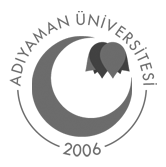Other Scientific Studies
Following the first light acquisition at the Adıyaman University Observatory, scientific studies were initiated, leading to the approval in 2015 of a project titled “ASAS Survey of Twin Binary Stars” under the “Scientific and Technological Research Projects Support Program” (1001 Program) of the Scientific and Technological Research Council of Turkey (TÜBİTAK). This project was jointly conducted by Adıyaman University and Akdeniz University. The project was led by Prof. Dr. Volkan BAKIŞ from the Department of Space Sciences and Technologies at Akdeniz University, with Prof. Dr. Eda SONBAŞ DHUGA from the Department of Physics at the Faculty of Arts and Sciences of Adıyaman University participating as a researcher. The project was successfully completed in 2019.
In line with the objectives of the Adıyaman University Observatory, conducting scientific research through international collaborations has always been a priority. In this context, a major international initiative was undertaken involving more than two dozen optical telescopes—including ADYU60—from countries such as Japan, South Korea, India, Turkey, Greece, Finland, Poland, Germany, the United Kingdom, Spain, the United States, and Mexico, as well as NASA’s Swift satellite. Under the leadership of Prof. Staszek ZOLA (Poland) and Prof. Mauri VALTONEN (Finland), a consortium of approximately 100 astronomers and astrophysicists collaborated to measure, with extremely high resolution, the spin rate of one of the most massive black holes in the universe. Using the general relativistic model proposed by Prof. VALTONEN for OJ287, the flaring times of OJ287 were successfully predicted, and observations were conducted with the ADYU60 telescope during these periods. Research on this topic is ongoing.
Furthermore, international collaborations have been initiated through joint studies led by the Andalusian Institute of Astrophysics (IAA) in Spain, with the participation of the ADYU60 telescope. As part of this collaboration, stellar occultation observations are being conducted at times predicted by the research team.
